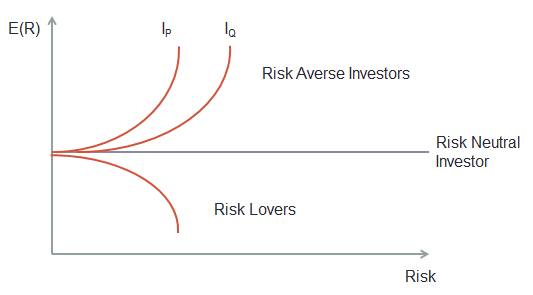Risk Aversion of Investors and Portfolio Selection
We have seen that different asset classes such as bonds, stocks, and commodities provide different levels of risk and return to investors. However, we also know that these investment options are not equally preferred by all investors. An equity stock providing high returns may be suitable for one investor but another investor may want to avoid such an investment. This happens because of the different attitudes of investors towards risk. A portfolio manager will consider the risk profile of his client investors and try to match his portfolio investment in such financial instruments that have the similar risk-return profile.
This concept is called risk aversion. In general, risk aversion refers to the behaviour of investor to prefer less risk to more risk. A risk averse investor will:
- Prefer lower to higher risk for a given level of expected return
- Accept high risk investment only if expected returns are greater
Let’s take a simple example to understand this. Assume that an investor has been offered two choices. In the first choice he will receive $100 for sure. In another choice, there is a 50% chance that he will receive $200 and another 50% chance that he will receive nothing. We can have some understanding of what kind of an investor he is depending on the choice he makes. The following figure shows the risk-return profiles of different types of investors.

Risk Neutral Investor
A risk neutral investor is someone who is only concerned about the return but does not worry about the risk posed by the investment. As long as an investment provides high returns, this type of investor will go for it. In our example, a risk-neutral investor will be indifferent between the two choices. He will look at both choices 1) $100 for sure, and 2) 50% nothing and 50% $200, as the same. In general, investors are not risk neutral. An investor may be risk neutral if the investment is not so significant. For example, a very wealthy investor will be indifferent to whether he receives $100 guaranteed or goes for the gamble.
Risk Averse Investor
As we mentioned earlier, most investors are risk-averse, that is, they want to reduce the amount of risk they take for a given level of return. If the returns provided are higher, they will be willing to take proportionately higher risk. In our example, such an investor will go for guaranteed $100. In fact, depending on his risk aversion, he may even be willing to accept slightly lower returns (say $90 instead of $100) for the certainty he gets. Different investors will exhibit different degrees of risk aversion. In the figure above, the two investors IP and IQ have different levels of risk aversion. Investor IP is more risk averse than investor IQ as investor IP demands more return for every additional unit of risk in the investment.
Risk Lover/Risk Seeker
The third category of investor is a risk lover. In our example, such an investor will choose to gamble because it’s not about the returns. Rather he loves taking risk, and gets additional pleasure by taking the risk. A risk lover definitely wants to increase his returns but his utility (level of happiness) increases from the extra risk that he takes. For risk lovers, the risk-return curve slopes downwards, i.e. the return they receive reduces and the risk increases. This is the typical profile of a gambler.


